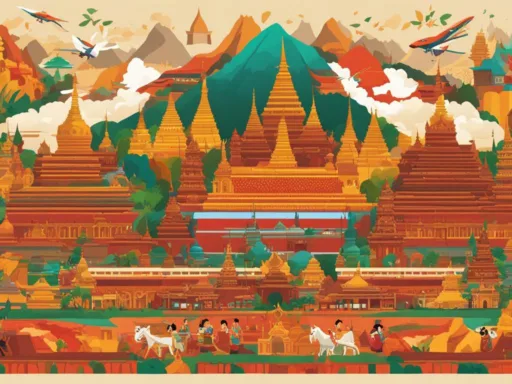Azerbaijan, situating itself as a vibrant crossroads of culture and trade, naturally exhibits a rich tapestry of languages. The nation prides itself on a linguistic diversity that is both deep-rooted and dynamic, with Azerbaijani holding the esteemed position as the official language Azerbaijan consistently celebrates. This Turkic language, flourishing within every corner of Azerbaijan, extends beyond its primary status, serving as a bridge that connects an eclectic population.
Moreover, the panorama of languages spoken in Azerbaijan expands to embrace a spectrum of minority languages. From the mellifluous sounds of Lezgian and the cadence of Talysh to the versatility of Russian and the precision of Tat, these languages contribute to the nation’s dialogue of diversity. While Azerbaijani enjoys ubiquity, the preservation of language minority communities illustrates Azerbaijan’s ongoing commitment to cultural inclusivity.
The country’s linguistic richness doesn’t pause there; it is further augmented by the presence of foreign languages. English, Russian, and Turkish are languages that not only thrive but also provide Azerbaijanis with corridors to global communication, education, and economic opportunity. Within this multilingual milieu, citizens move seamlessly between languages, celebrating a heritage that is uniquely Azerbaijani while facing forward to a multilingual future.
As Azerbaijan looks ahead, the enduring narrative of its languages—from the majestic sway of Azerbaijani to the hum of endangered dialects—continues to be a story worth telling.
Key Takeaways
- Azerbaijani is the official language and is predominantly spoken throughout Azerbaijan.
- A stunning array of minority languages exists alongside Azerbaijani, adding to the nation’s linguistic heritage.
- English, Russian, and Turkish play a significant role in the country’s engagement with education and global communication.
- The nation exhibits a commitment to linguistic inclusivity and diversity.
- Azerbaijan is actively involved in efforts to preserve the integrity of its endangered languages for future generations.
Linguistic Diversity Azerbaijan: A Melting Pot of Languages
The land of Azerbaijan resonates with a symphony of languages, each playing an instrumental role in crafting the nation’s unique linguistic mosaic. This multicultural ensemble is more than a collective medley; it’s the heartbeat of a region where communication converges with culture, and tradition interweaves with modernity. Language is the fulcrum upon which Azerbaijani society pivots, celebrated in its myriad forms and functions.

At the forefront of this linguistic landscape, the Azerbaijani language emerges, proud and prominent. It commandeers the title of the official language, spoken by the vast majority of the populace. This Turkic tongue shares its roots with Turkish and dances through the daily discourse of Azerbaijan, from the bustling markets of Baku to the tranquil villages of the hinterlands.
Azerbaijani: The Official and Dominant Language
Illuminating the core of Azerbaijan’s language policy, Azerbaijani boasts not only official status but also claims the allegiance of 92.5% of its citizens. In an intricate interplay of linguistic uniformity and diversity, the Azerbaijani language serves as both the banner of unity and the voice of the people. Educational institutions and governmental communications revere this vernacular, ensuring its dominion amidst the country’s dynamic language policy Azerbaijan is known for.
Minority Languages: Richness in Diversity
Traversing the lush linguistic landscape, one uncovers the richness in diversity that is encapsulated by minority languages. The polyphonic chorus of languages such as Lezgian, Talysh, and Avar endorses the cultural cornucopia of Azerbaijan. Even with their discordant plight against modernization and emigration, these languages persist, a testament to the undying spirit of linguistic diversity Azerbaijan treasures. Yet, they now teeter on the precipice of endangerment, awaiting the crucial embrace of language preservation initiatives.
The Influence of Foreign Languages in Modern Azerbaijan
Language learning in Azerbaijan has fraternized beyond native tongues. A growing engagement with English language proficiency reflects a progressive trend—though considered the least proficient among its European counterparts in 2019, Azerbaijan exhibits an illustrious inclination towards embracing English. Russian, with its historical heft, continues to hold academic sway, while Turkish bridges linguistic kinship, strengthening foreign language proficiency journeys within the nation. These languages, external threads woven into the fabric of Azerbaijani society, propel its citizens towards the portals of global opportunity and understanding.
The Historical Tapestry of Azerbaijani Language
The story of the Azerbaijani language is a vivid illustration of the history of Azerbaijan and the intricacies of language evolution. Rooted in the Oghuz Turkic branch, Azerbaijan’s primary language stands as a testament to the nation’s vibrant past and cultural cross-pollination. The imprints of Persian and Arabic, evident in its syntax, vocabulary, and phonology, spotlight the language’s journey through the ages and its role as a historical lingua franca in the region. This melding of tongues underlines the significant influence Persian literature exerted on Azerbaijani during its formative period.
The Azerbaijani language has traversed a complex historical trajectory, emerging as a powerful medium of expression under the rule of various monarchies, notably the Safavids, Afsharids, and Qajars. This period marked its spread across the Caucasus and into Eastern Europe, a pivotal chapter in the language evolution Azerbaijan experienced during medieval migrations. As a language of the court and culture, Azerbaijani ascended to become a dominant force in the region, echoing through the corridors of power and the halls of learning.
| Period | Influences | Impact on Azerbaijani Language |
|---|---|---|
| Medieval Era | Oghuz Turkic Migrations | Formation of Azerbaijani as a distinct language within the Turkic family |
| Safavid Dynasty | Persian Literary Traditions | Inclusion of Persian vocabulary and literary styles |
| Afsharid and Qajar Dynasties | Arabic and Islamic Scholarship | Integration of Arabic terms and Islamic concepts |
| Modern Era | Language Standardization Efforts | Unified literary language and adoption of Latin script post-independence |
Evocative of its storied past, Azerbaijani continues to flourish, echoing through time as the voice of a nation. The harmonious blend of ancient influences with modern sensibilities showcases the dynamic nature of Azerbaijani, making it a fascinating subject for both linguistic enthusiasts and historians alike. With each phrase spoken or written, the history of Azerbaijan is told anew, and the ongoing language evolution Azerbaijan undergoes is further penned in the annals of time.

Languages Spoken in Azerbaijan: From Dominant Dialects to Minority Tongues
In Azerbaijan, a land where ancient caravans once threaded the Silk Road, the echoes of diverse tongues map a storied past and an intricate present. Azerbaijani, serving as both sentinel and symbol of the nation’s identity, shares the stage with a spectrum of languages that testify to the country’s role as a cultural confluence. As the national language weaves through the fabric of daily life, the call of the Azerbaijani interpreter is a testament to the need for bridges between languages, fulfilling the vision for a linguistically inclusive Azerbaijan.
The Official Language: Azerbaijani’s Prevalence and Use
Enshrined as the official language, Azerbaijani frames the discourse of the nation’s trajectory—anchored in the principles of the language policy Azerbaijan upholds. The tongue sings in the Shirvani dialect, stamping a literary standard in the Republic, while the Tabrizi dialect infuses life into Iranian Azerbaijan’s lexicon. In governance, media, and the hum of life’s conversations, Azerbaijani remains omnipresent, an unperturbed constant in the ever-evolving narrative of the nation’s language heritage.
Minority Languages and Their Status in Azerbaijan
The palette of languages within Azerbaijani borders vividly illustrates the ethnic tapestry the region boasts—each thread a minority language, each hue a community’s voice. Russian and Armenian fill pockets of the linguistic landscape, while tongues like Budukh and Khinalug whisper in the mountains, holding on in a climate of modernity that often favors the majority. With the European Charter for Regional or Minority Languages still awaiting ratification, these minority scripts face a future hinged on crucial decisions impacting language diversity Azerbaijan treasures.
Endangered Languages: Preserving Azerbaijan’s Linguistic Heritage
The hushed tones of endangered languages in Azerbaijan, such as Juhuri, Kryts, and Udi, reverberate with the fragility of relics on the brink of silence. Steadfast against the waves of modernization and diminished transmission, these languages grasp for survival. Empowered by advocacy and research, the classification of Tsakhur, Rutul, and Tat as “definitely endangered” by entities like UNESCO kindles a fight for linguistic preservation. The unyielding efforts to protect them underscore Azerbaijan’s dedication to safeguarding a legacy that speaks in many tongues.
It is within the classrooms and the quiet resolve of communities that the preservation of languages in Azerbaijan thrives. Language is not merely about communication; it encodes the worldview, traditions, and unspoken connective threads of its speakers, and in this understanding, Azerbaijan endeavors to stand as a bastion for the preservation of its linguistic mosaic.

In building a future where language diversity finds its voice and endangered languages escape the precipice of forgetfulness, Azerbaijan treads a path both challenging and necessary. Across communities and generations, the commitment to linguistic heritage remains vibrant, a harmony entwined with the echoes of ancestors and the aspirations of descendants, each a custodian of Azerbaijan’s multilingual legacy.
Azerbaijani Language and Dialects: Understanding the Differences
The intrinsic unity of the Azerbaijani language does not hinder the existence of regional varieties that make the language rich and diverse. North vs. South Azerbaijani dialects manifest distinct lexical choices, phonetic nuances, and syntactic features that reflect the intricate history and social fabric of Azerbaijan. The North, characterized by its embrace of the Latin script after Azerbaijan’s independence, contrasts with the South’s continued use of the Perso-Arabic script. Despite these differences, Azerbaijani persists as a cohesive language across borders, offering a prime example of language diversity Azerbaijan celebrates.
North Azerbaijani vs. South Azerbaijani: A Comparative Glance
When assessing the dialectal differences Azerbaijan presents, one notes the parallels and divergences between North and South Azerbaijani. Variants such as the Shirvani and Tabrizi dialects evidence a language shaped by its geography and history. These dialectal differences are not simply of academic interest; they play a dynamic role in daily communication and are a signifier of cultural identity for the speakers inhabiting different regions of Azerbaijan.
Dialectal Variants Within Azerbaijan’s Borders
Azerbaijani dialects do not merely distinguish the North from the South; within the nation’s own borders, there is a rich array of vernaculars thriving in linguistic enclaves. Azerbaijan’s commitment to fostering language diversity is witnessed in the standardization efforts that resonate across dialects, preserving the nuanced character of each while maintaining intelligibility across the Azerbaijani-speaking world.
Linguistic Evolution: The Impact of Persian and Arabic
Language is an ever-flowing river, charting a course through time and society, with tributaries of influence that reshape the language landscape. Azerbaijani is no exception, having absorbed the Arabic influence Azerbaijani traders, scholars, and poets have encountered over the centuries. The Persian influence Azerbaijani has also inherited through extensive literary and scholarly intercourse is present in the modern language, enriching it with a complexity and resonance that echoes through Azerbaijani literature and everyday speech. This confluence makes Azerbaijani a language not only reflective of a storied past but also adaptable to the rich tapestry of its contemporary usage.
FAQ
What languages are spoken in Azerbaijan?
Azerbaijan is linguistically diverse, with Azerbaijani being the official language. Other languages spoken include minority languages such as Lezgian, Talysh, Avar, and Russian, as well as the foreign languages of English and Turkish, reflecting its cultural and historical affiliations.
Is Azerbaijani the only official language of Azerbaijan?
Yes, Azerbaijani is the sole official language of Azerbaijan and is used extensively in government, education, and media. It is spoken as a first language by the majority of the population.
Are there minority languages in Azerbaijan?
Indeed, Azerbaijan harbors a variety of minority languages including Lezgian, Talysh, Avar, Tat, and others. These languages contribute to the country’s rich cultural mosaic, though some face threats of diminishing use and even extinction.
How has the Azerbaijani language been influenced by foreign languages?
Over time, Azerbaijani has absorbed elements from many languages, particularly Persian and Arabic, due to historic connections. It is also under increasing influence from English and Turkish, as Azerbaijan fosters global ties and linguistic kinship.
What is the history of the Azerbaijani language?
Azerbaijani evolved from the Oghuz Turkic branch and has been shaped by Persian and Arabic languages throughout its history. It became a lingua franca in the region, historically supported by regional powers such as the Safavids and the Qajars.
How does the language policy in Azerbaijan affect minority languages?
Language policy in Azerbaijan emphasizes the use of Azerbaijani, leading to concerns about the vitality of minority languages. Efforts are needed to preserve these languages, as the nation has not ratified the European Charter for Regional or Minority Languages.
What are some of the endangered languages of Azerbaijan?
Languages such as Juhuri, Kryts, Udi, Tsakhur, Rutul, and Tat are among the endangered languages in Azerbaijan. They face challenges from modernization and limited intergenerational transmission, prompting calls for preservation and revitalization efforts.
What are the main differences between North Azerbaijani and South Azerbaijani?
North Azerbaijani, which is used in the Republic of Azerbaijan, primarily utilizes the Latin script, while South Azerbaijani, spoken mainly in Iran, uses the Perso-Arabic script. There are phonological, lexical, and syntactical variations between these two dialects, although they remain mutually intelligible.
How do the dialects within Azerbaijan differ from the standard Azerbaijani language?
Dialects within Azerbaijan, such as the Shirvani and Tabrizi dialects, exhibit unique characteristics influenced by historical and regional factors. Despite the standardization efforts, these dialects preserve specific linguistic features that reflect the nation’s diverse linguistic heritage.
How have Persian and Arabic influenced the Azerbaijani language?
Persian and Arabic have profoundly influenced Azerbaijani, contributing to its syntax, vocabulary, and phonology. These influences came about through literary and scholarly exchanges, as well as religious texts, enriching Azerbaijani’s depth and making it indicative of the region’s multifaceted history.






